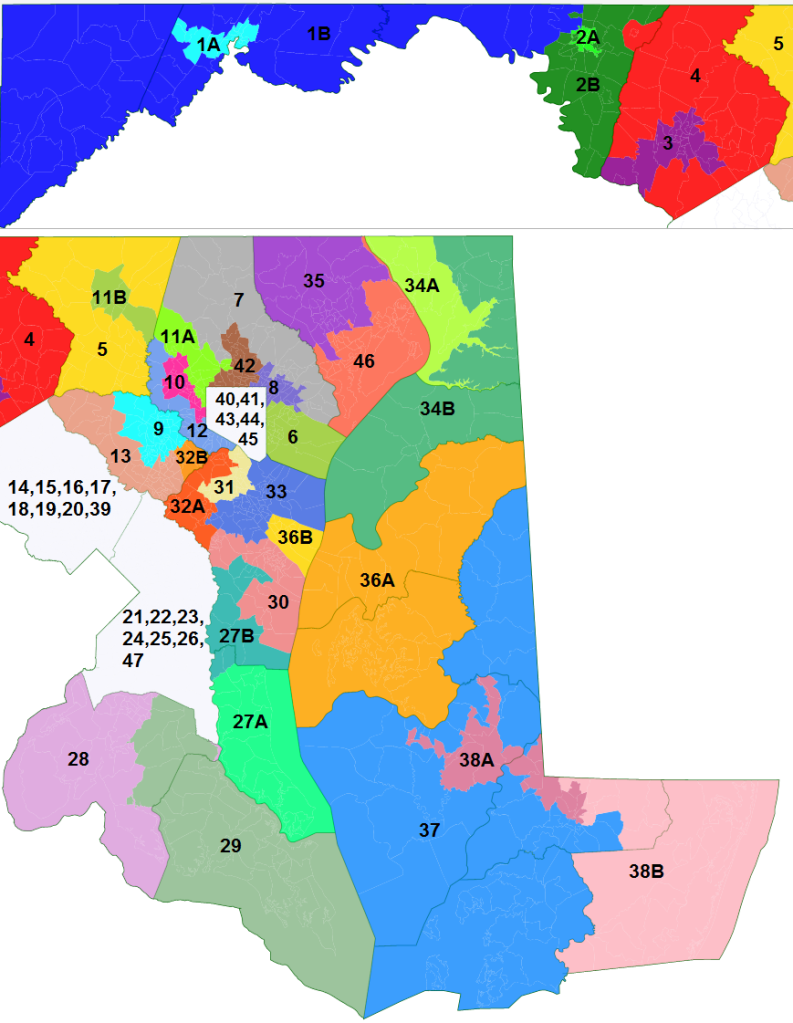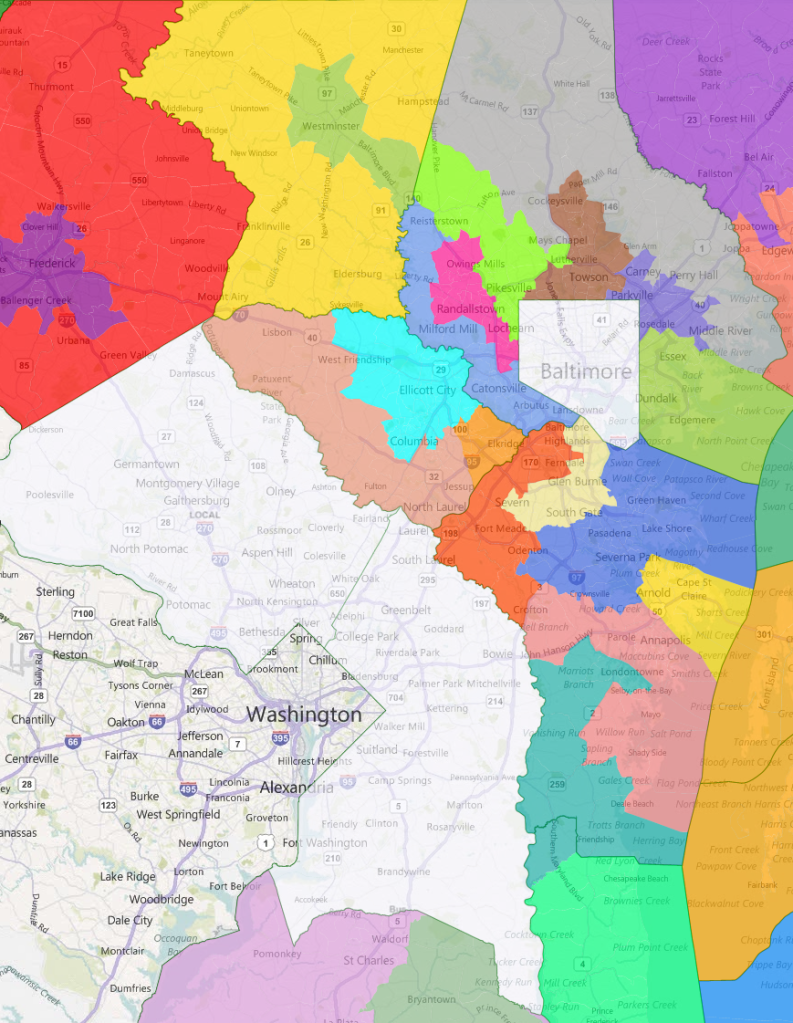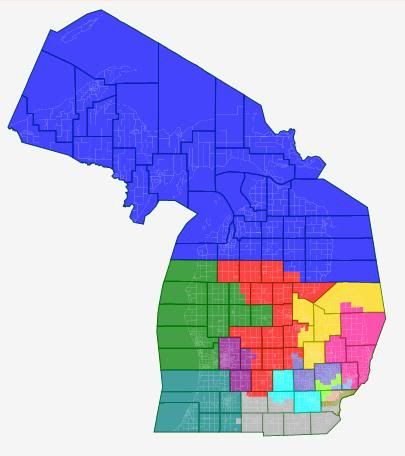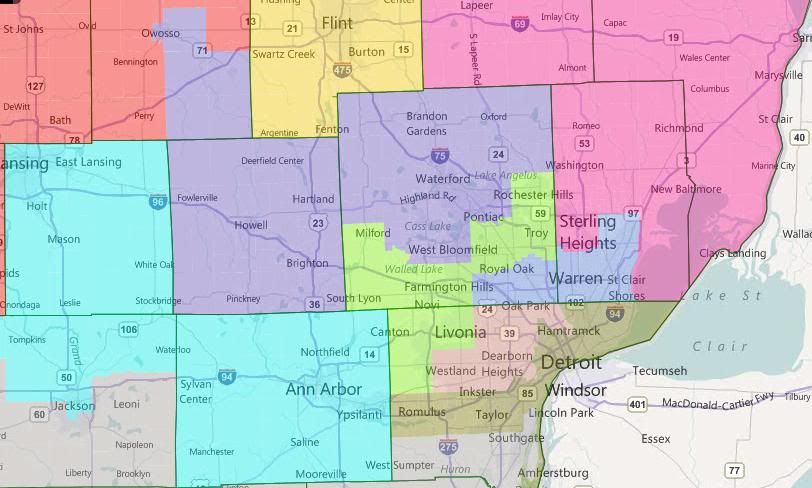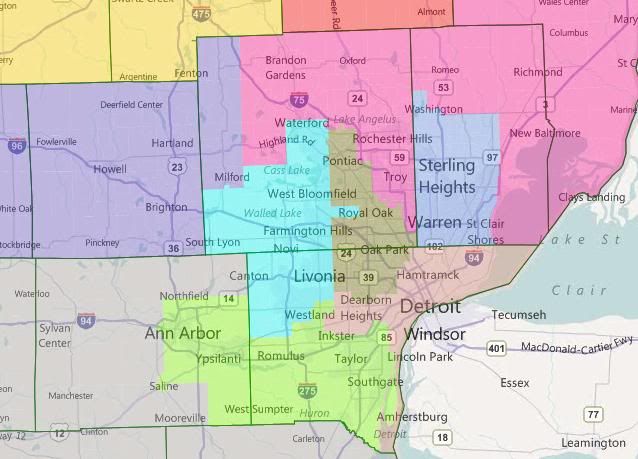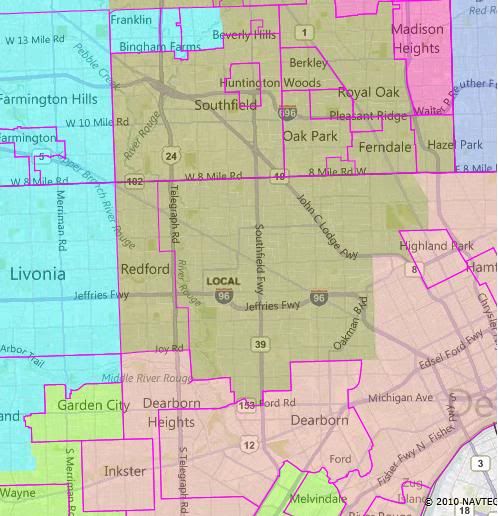Ok, I drew this one of New York. This seems more likely to happen, as Cuomo has said he would veto any gerrymandered map. Also, if they pass an independent redistricting bill then this becomes a possibility too. Tried to split as few counties as possible. In NYC, protected the VRA districts of Clarke, Serrano, Meeks and Towns. With the majority-minority districts (Velasquez, Crowley) they move but keep that status. Tried not take incumbents into consideration at all.
Ok lets start again in West NY:
27 (TEAL): Higgins gets a compact Buffalo based district. 62 % Obama. SAFE D
26 (BLACK): Chris Lee’s ex district. Sucks in all the area in between Rochester and Buffalo. 46% Obama. STRONG R.
5 (YELLOW): Slaughter gets a district which is most of Monroe County. Obama 58.5%. STRONG D. This could theoretically be competitive when Slaughter retires, but probably not.
25 (PINK): Finger lakes district for Tom Reed. Obama 46 %. STRONG R.
24 (PURPLE): District with Syracuse and Ithaca. Mayor of Syracuse would prob win this one. Obama 59%. Contains the SW portion of Richard Hanna’s district, but not his hometown of Utica. SAFE D
23 (LIGHT BLUE): This contains the 6 North Country counties, as well as Utica and Rome. Obama 52%. Richard Hanna would probably run here versus Bill Owens. Lean D.
20 (PALE PINK): This contains the adirondeck areas: Schnectedy, Saratoga Spring, Glens Falls and Lake George are here. Scott Murphy would probably run here. Chris Gibson currently represents this area, but lives in the Southern part of the district. Obama 49 %. TOSSUP.
22 (BROWN): Contains Binghamton and the Catskill area. Hinchey’s hometown of Ithaca is in the Syracuse district, but most of the area he represents is in this district. Dems might be better off with a different candidate though. Obama 54%. Lean D.
21 (MAROON): Contains Albany, Troy, and parts east of the Hudson down to Pougkipsie and Hyde Park. Gibson’s home is in this district. Tonko would probably be safe though in this Obama 58% district.
19: NYC Exurbs, most of Rockland, Dutchess, Orange county. Hayworth represents most of this area, even though her home is not in this district. She would probably run here rather than against Nita Lowey. Obama got 49 % here. Lean R due to Republican Incumbent.
18: All of Central and Northern Westchester, as well as the soundshore. The only part not includes are the southern cities of Yonkers, New Rochelle, Pelham and Mt. Vernon. Also goes over the Tappan-Zee Bridge to grab Nyack from Rockland County. Obama 60%. Safe D for Lowey.

17 (BLUE): Eliot Engel would probably run in this district. Contains Southern Westchester as well as the Northern Bronx. Engel’s worry would be the primary here, as it is an 80 % Obama district. W 31 B 33 H 27 A 4.
16 (LIME): Serrano South Bronx district stays the same. Obama 95%. W 3 B 30 H 62 A 2.
15 (ORANGE): Rangels district moves a little further south in Manhattan, down to 90th St. Obama 92%. W 19 B 29 H 46.7
14 (PUKE): Takes in UES, UWS, Midtown, Greenwich Village area and some of Downtown. Obama 81 %. Maloney is safe here still.
9 (LIGHT BLUE): This district takes in some of Crowley’s former areas in the Bronx, as well as Flushing, Bayside, and part of Forest Hills NE of Queens Blvd. Ackerman and Weiner would probably duke it out here, with Ackerman having repped most of this area but Weiner being more popular with the base. Weiner could also just retire and focus on his mayoral run. W 42 B 9 H 22 A 22 and Obama 68 %.
7 (SILVER): This district contains Astoria, Corona, Jackson Heights and Woodside. Has Crowley’s home and some of his area. Would probably face competition from Joel Peralta and maybe Mike Gianaris. Obama 78 % and W 27 B 8 H 41 A 20.
12 (LIGHT BLUE): Takes in some of Weiners old ground (Western Rockaway, SW Queens) and some of Velasquez’ area (Williamsburg, Brooklyn Heights etc). Obama 75 %, W 42 H 37 B 8 A 8. Not really sure who would win a primary here between Velasquez and Weiner, but this district may have more of Weiner’s district than the one based in Flushing.
11-10 (PINK AND GREEN), 6 (TURQUOISE): Towns and Yvette Clark’s (+Meeks) districts stay pretty much the same and above 50 % black. So they are good under the VRA.
8 (DARK BLUE): Takes in downtown Manhattan and Southern Brooklyn, taking in both Orthodox Jewish and Hispanic areas. Obama 65 % W 52 H 20 B 3 A 22. Nadler probably safe here, but could face a challenge from a more Brooklyn based primary challenger.
13 (SALMON): Takes in Staten Island as well as Coney Island, Sheepshead Bay and other heavily Russian areas in Brooklyn. Obama 49 %, probably a toss up between Grimm and McMahon in a likely 2012 rematch. A point more democratic than the current district.
4 (RED): McCarthy’s district takes in all the inner Nassau Suburbs and tiny piece of Queens. Obama 58 %.
3 (PURPLE): King loses his huge tendril into Suffolk, and therefore his district becomes much less Republican. The flip side of that is that Israel’s seat will be more Republican. Obama 51 %, LEAN R.
2 (GREEN): Israels district now solely in Suffolk county. Obama 53.5 %, as he has to take in some of King’s area’s from the South Shore. LEAN D
1 (BLUE): Bishop’s district stays the same. LEAN D. Obama 52%.
So what independent districting would do is give us one extra safe D seat in Syracuse, throw a Lean D race between Owens and Hanna, gives Scott Murphy a clear comeback shot, weakens Hinchey, King, Israel, and takes apart Gibson’s district and totally un-gerrymanders Queens.












